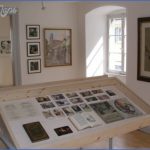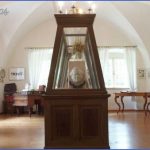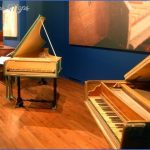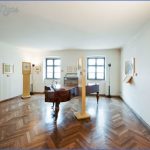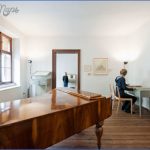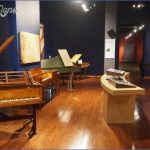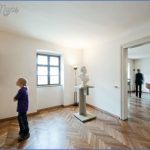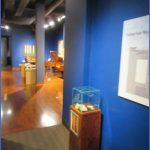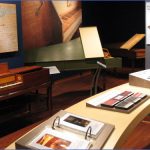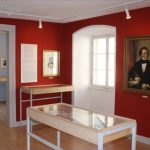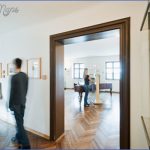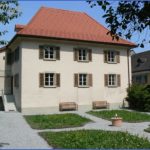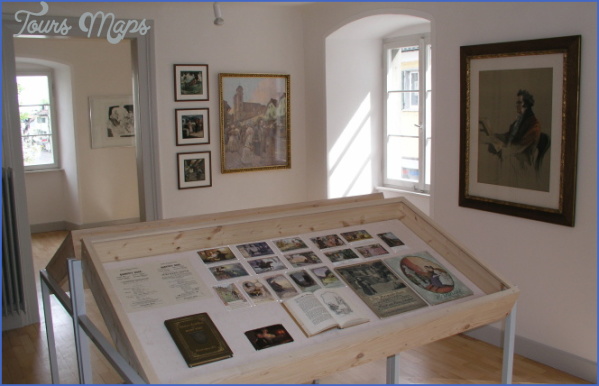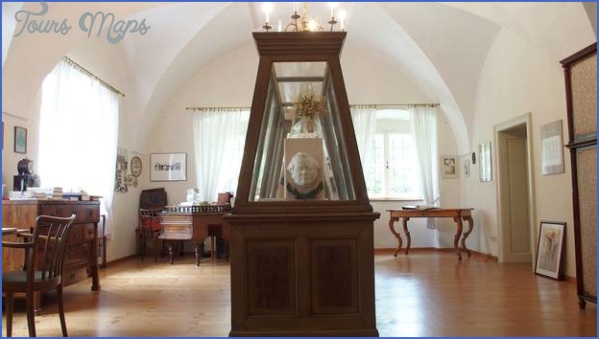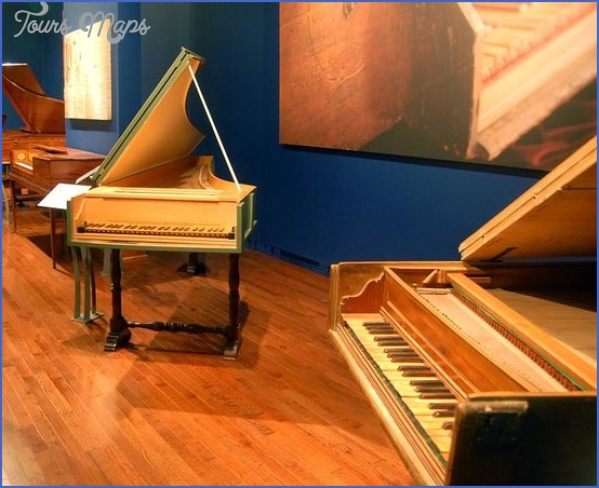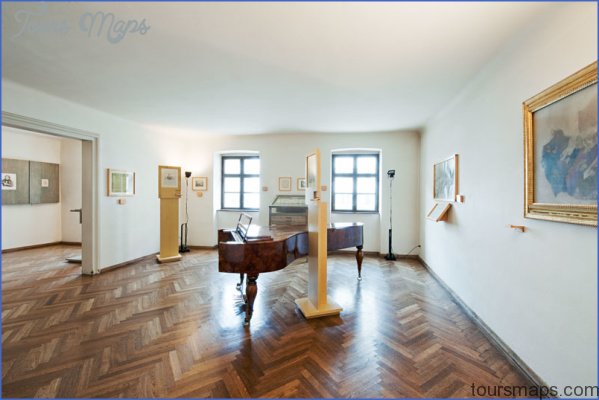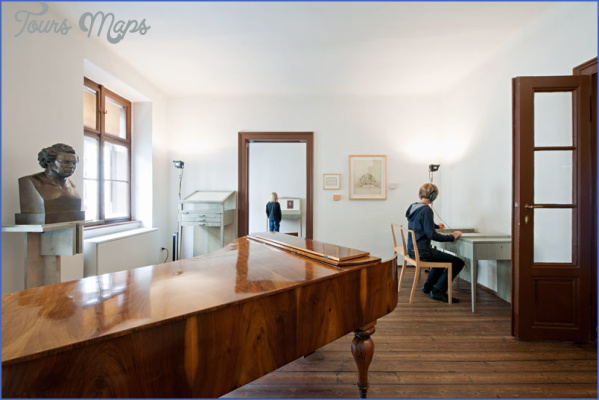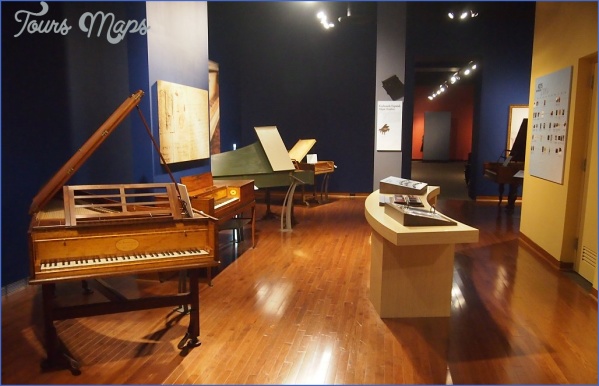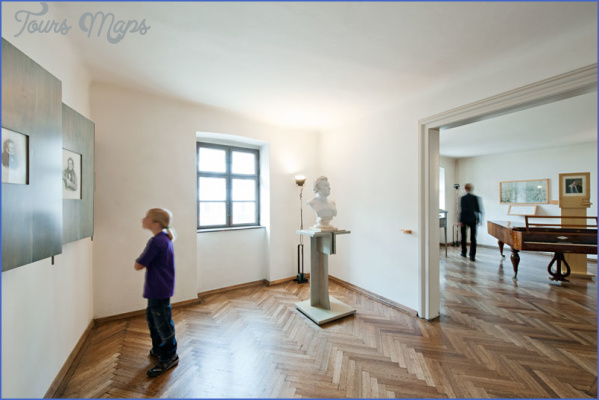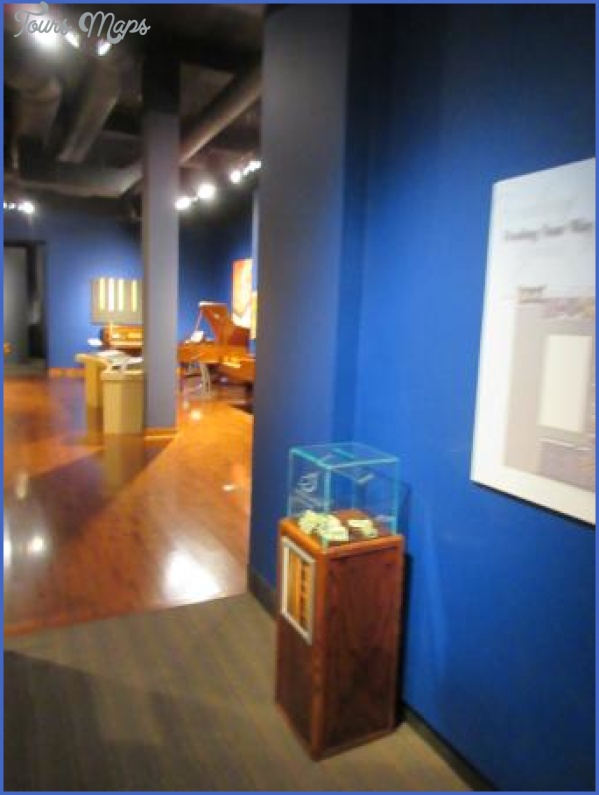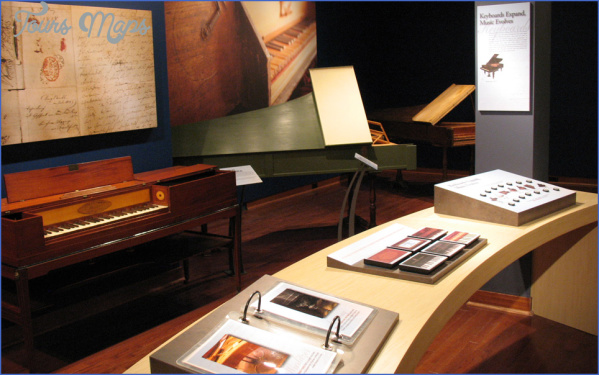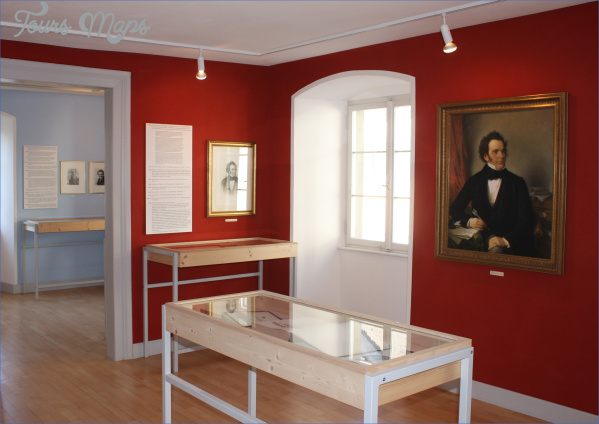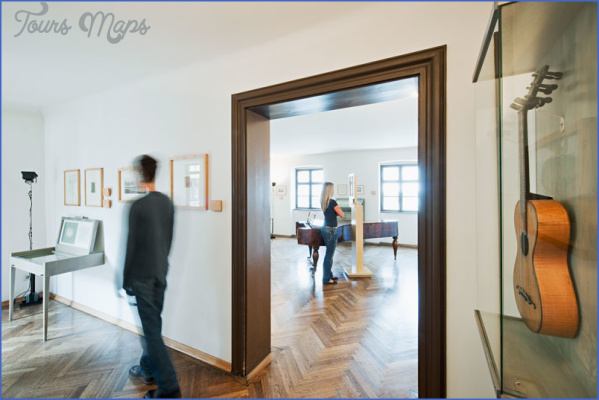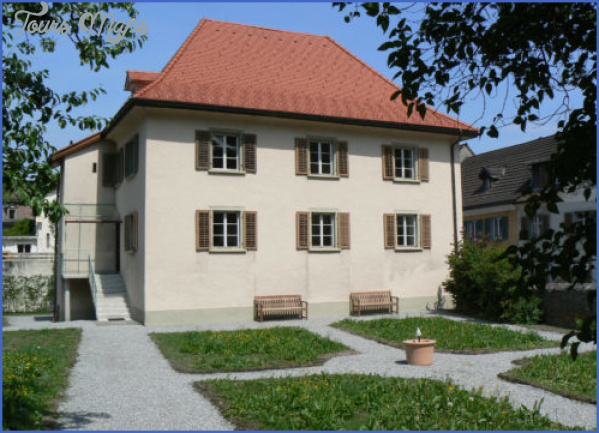SCHUBERT MUSEUM
Schubert lived something of a peripatetic existence in Vienna, as had Mozart and Beethoven. He left a string of addresses, of which two, his first and his last, are now museums. Accordingly, there are nearly two dozen Schubert memorial sites of various kinds, with plaques, on houses (including the ‘Erlkonighaus’ at Saulengasse 3), churches and inns and in parks. These assist the dedicated Schubertian determined to recapture something of the flavour of his life, or at least to follow in some of his footsteps and plot his movements on a city map, taking in the locations of the coffeehouses and inns he frequented, the venues where his music was performed and the homes of friends where his circle foregathered. Franz Peter Schubert was born on 31 January 1797 in a first-floor flat over the school where his father taught. The address, in the northern suburb of Himmelpfortgrund, called ‘Zum roten Krebsen’ (‘The Red Crab’), was at first Obere HauptstraBe 42, then no.72; later it was renamed and renumbered as NuBdorfer StraBe 54. The Schubert family occupied two of the 16 tiny flats – one for the school, one for the family – between 1786 and 1801. There 12 children, of whom four survived to adulthood, were born to the composer’s parents.
SCHUBERT MUSEUM Photo Gallery
The birthplace museum, founded in 1912 and recently renovated, now incorporates several rooms from the adjoining flats. The kitchen and the single living-room, facing on to the street, which once made up the entire family lodging, are distinguished from the rest of the museum by their simplicity: the kitchen, where the Schubert children are supposed to have been born (on no firmer evidence than that it was probably the warmest place to be), is devoid of ornament, while in the living-room there is nothing to be found but a bust of the composer and a vase. In the adjacent rooms there are pictures offering a survey of the people and places central to Schubert’s life. Also on display are first editions, facsimiles of his music autographs and his diaries, letters, concert programmes and press reviews, as well as his guitar and a grand piano that belonged to his brother Ignaz. His pathetic steel-framed glasses, their lenses shattered, and a lock of hair taken when his body was exhumed in 1863, are unforgettable. The rooms are modest in size but adequate for the Schubertiade that are held there eight times a year. Outside Vienna itself, just off the St Polten road (north of the Linz motorway, south of the Danube), some 40 km west of the city, is a Schubert-Gedenkstatte at SchloB Atzenbrugg, commemorating ‘Franz Schubert und sein Freundeskreis’. Atzenbrugg is unique among composer museums for the extent to which it brings to life the leading figures in the composer’s circle and throws light on his social life. Originally the property of the Klosterneuburg monastery, the building, with its chapel and vaulted ceilings, has suffered the ravages of war many times over the centuries – from the Turks, from Napoleon and in World War II. It was last restored in 1977. In Schubert’s day the steward of the SchloB was Josef Derffel, an employee of the monastery and an uncle of Franz von Schober; he offered hospitality to his nephew’s friends each summer from 1817 to 1822 for house parties or ‘Atzenbrugg Feasts’. Schubert himself first went in 1820. The high spirits and the ambience of these gatherings of members of the young, liberal intelligentsia are captured in the well-known watercolours of another member of the circle, Leopold Kupelwieser; in these and other pictures SchloB Courtyard at Schubert’s birthplace Schlofi Atzenbrugg ‘Gesellschaftsspiel der Schubertianer im Atzenbrugg’ (watercolour by Leopold Kupelwieser) Atzenbrugg itself is easily recognizable, inside and out, as is the recurrent bespectacled image of Schubert himself. Kupelwieser drew separate portraits there of Schubert and Schober. Since 1978, after a pause of more than 150 years, annual Atzenbrugger Schubertiade have taken place from the end of May to the end of June and on Saturdays in September.
The museum, established in 1986 through private initiative, is on two floors. A circular staircase leads to the Schubert-Saal, a concert hall seating some 120, lined with reproductions of Schubert family portraits. Surrounding it is a series of carefully conceived display rooms, each of them devoted to one of Schubert’s friends, including Kupelwieser, the painter Moritz von Schwind, Schober himself, Schubert’s school friend the poet Johann Mayrhofer, the singer Johann Michael Vogl, his patron Josef von Spaun and his piano duet partner, the dramatist Eduard von Bauernfeld. On the ground floor one room commemorates the Sonnleithner family and also the Huttenbrenners and Grillparzer.
Not quite so readily accessible is another country museum, in the small town of Zeliezovce, about 200 km east of Vienna in the south-east corner of Slovakia, close to the Hungarian border (Zseliz in Hungarian, which is equally spoken there) and near the river Hron, a Danube tributary. Here Count Johann
Esterhazy had one of his family country residences and Schubert, as music-master to the daughters, first went there in the summer of 1818.
There at the beginning of August he composed the song Einsamkeit (‘Loneliness’) – ‘the best I have done’, he wrote to Schober – which however turned out prophetic: a month later he was complaining that at Zseliz he had no choice but to amuse himself: ‘I have to be composer, author, audience and goodness knows what else’. He also wrote piano duets for his pupils and the Deutsches Requiem for his brother Ferdinand to pass off as his own. He was there again in 1824, when he wrote the vocal quartet Gebet and various piano duets including the op.140 Grand Duo.
The Esterhazy Schlofi, a charming classical building in spacious parkland, dating from 1787, is not open to the public and is in need of restoration. Schubert himself is believed to have stayed in one of the two lodges, not far away; one no longer stands (significantly, when it was demolished music manuscript paper was found under the wallpaper), leaving the other, known as the Owlet’s Eyrie, to serve as a little Schubert museum, which it has done since 1978. The ground floor is devoted to displays of local history (the town has existed for 900 years); Schubert’s time there is commemorated upstairs, in displays of contemporary furniture and reproductions of music and pictures of his friends.
The local citizens take some pride in the fact that the Esterhazy daughters Schubert memorial rooms at Zteliezovce inspired some of the finest of the four-hand music (the F minor Fantasy was dedicated to Caroline) and in the local legend that on his walks in the neighbourhood Schubert visited the mill in the next village, where the miller’s wife inspired Die schone Mullerin (the chronology is a little shaky, but the idea is appealing).
Back in Vienna, the second Schubert museum is found in the flat that belonged to his brother, at a house called ‘Zur Stadt Ronsperg’, now Kettenbruckengasse 6, in what was then the fairly new southern suburb of Wieden. A plaque was erected on the house in 1869 and the flat was renovated by the Vienna Municipal Museums in 1979 and then again in 1996; the Internationales Franz Schubert Institut also occupies premises in the building.
Ferdinand, three years senior to Franz and himself a composer, if of modest achievement, moved into the second-floor flat (no.17) with his family in August 1828. Already seriously ill, Franz joined them on 1 September; he had been told to seek the fresher air of the suburbs by his doctor, who had not reckoned with the dampness of the new building or its poor sanitation (though probably that made little difference). He set some Heine poems (including Der Doppelganger) and completed the B flat Piano Sonata there in September, as well as correcting the Winterreise proofs, and was well enough to make a three-day pilgrimage on foot to Haydn’s grave in Eisenstadt in October, when he also wrote Der Hirt aufdem Felsen and his last Lied, Der Taubenpost. But by 11 November he was bedridden, in a little side room (about two metres by five). In his last letter, of 17 November, he asked Schober to bring him novels by James Fenimore Cooper. Two days later he was dead, at the age of 31.
During his last illness Schubert had been devotedly nursed by his brother and his family. Friends visited him; at his request a performance of Beethoven’s op. 131 String Quartet was given in the next room, where now Ferdinand’s
Elwerkember piano and mahogany writing desk are displayed. The flat was small; today it consists of just three rooms and an entrance hall. The tiny bedroom, which in his final delirium Schubert, according to his brother, mistook for a grave, is not now set out as a bedroom (if it were, one could do no more than peer in). Ferdinand’s career is also represented in the museum, as both a composer and a purloiner of his brother’s music.
Most of the items on display are necessarily sombre in character, relating to the last music he composed, the last letters he wrote and last people he saw. Reproductions of Bauernfeld’s poignant diary entry for 20 November, describing Schubert as ‘the most honest soul’ and the ‘most loyal of friends’, and expressing the wish that he might have taken his friend’s place, are among the many items relating to Schubert’s death, funeral and commemoration displayed in the museum; there are also letters exchanged by Schubert’s father and brother, along with invitations to Schubert’s Requiem Mass at St Ulrich’s on 27 November and to the memorial service at the Augustiner-Kirche on 23 December, and lithographs of his tomb.
Room XV in the Vienna Kunst-historisches Museum, in the Sammlung alter Musikinstrumente, is devoted to Schubert: there is a bronze mask and several instruments of his time, chiefly pianos but also including an arpeggione, a rare bass string instrument for which he wrote a sonata (the solitary significant work in its repertory). There is a fine portrait of him by Wilhelm August Rieder in the Schubert Room of the Franz Schmidt Musikschule in the southern suburb of Perchtoldsdorf. Among the most notable Schubert monuments in the city – there are in all more than 20 plaques and the like – is the statue in the Stadtpark by Carl Kundmann, unveiled in 1872, with symbolic reliefs by Theophil Hansen on the pedestal; the same artists contributed the tomb in the musicians’ section of the Zentralfriedhof at Simmeringer HauptstraBe 234 when in
1888 Schubert’s remains were removed there from Wahring – where the original tomb, bearing Grillparzer’s notorious epigraph, still stands in what is now the Schubertpark (‘The art of music here entombed a rich possession, but still fairer hopes’). There is also a Schubert fountain in the AlserbachstraSe in the 9th district. Elsewhere in Austria there are at least a dozen Schubert plaques or other monuments, mostly recalling visits (including one in Salzburg, on the house at Judengasse 8 where he stayed in 1825) but some of them simply tributes from local lovers of his music.
Maybe You Like Them Too
- Explore East Lindfield, Australia with this detailed map
- Explore Bonferraro, Italy with this detailed map
- Explore Doncaster, United Kingdom with this detailed map
- Explore Arroyito, Argentina with this Detailed Map
- Explore Belin, Romania with this detailed map

